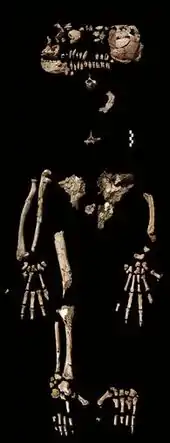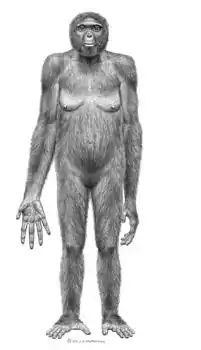Ardi
Ardi (ARA-VP-6/500) is the designation of the fossilized skeletal remains of an Ardipithecus ramidus, thought to be an early human-like female anthropoid 4.4 million years old. It is the most complete early hominid specimen, with most of the skull, teeth, pelvis, hands and feet,[1] more complete than the previously known Australopithecus afarensis specimen called "Lucy." In all, 125 different pieces of fossilized bone were found.[2]

Discovery
The Ardi skeleton was discovered at Aramis in the arid badlands near the Awash River in Ethiopia in 1994 by a college student, Yohannes Haile-Selassie, when he uncovered a partial piece of a hand bone. The discovery was made by a team of scientists led by UC Berkeley anthropologist, Tim D. White,[3][4][5] and was analyzed by an international group of scientists that included Owen Lovejoy heading the biology team. On 1 October 2009, the journal Science published an open-access collection of eleven articles, detailing many aspects of A. ramidus and its environment.[6] Her fossils were also found near animal remains which indicated that she inhabited a forest type of environment, contrary to the theory that bipedalism originated in savannahs.[7]
Ardi was not the first fossil of A. ramidus to come to light. The first ones were found in Ethiopia in 1992, but it took 17 years to assess their significance.[5]
Etymology
The word Ardi means "ground floor" and the word ramid means "root" in the Afar language,[8] suggesting that Ardi lived on the ground and was the root of the family tree of humanity.
Description

Ardi weighed about 50 kg (110 lb), and could be up to 120 cm (3.9 ft) tall. Although she is a biped, Ardi had both opposable big toes and thumbs in order to climb trees. It is speculated that her bipedality impeded movement, but enabled her to bear more offspring.[9]:67
Although it is not known whether Ardi's species is related to Homo sapiens, the discovery is of great significance and added much to the debate on Ardipithecus and its place in human evolution. With regards to Ardi's body composition, archaeologists note that she is unique in that she possesses traits that are characteristic of both extinct primates and early hominids.[9]:63 It is still a point of debate whether Ardi was capable of bipedal movement. Ardi's divergent big toes are not characteristic of a biped.[9]:66 However, the found remains of her legs, feet, pelvis, and hands suggested that she walked upright when on the ground but was a quadruped when moving around trees. Her big toe, for example, spreads out quite a bit from her foot to better grasp tree limbs. Unlike chimpanzees, however, her foot contains a unique small bone inside a tendon which kept the big toe stronger. When seen along with Ardi's other bone structures, this unique bone would have helped her walk bipedally, though less efficiently than Lucy.[10] Her wrist bones also provided her with flexibility but the palm bones were short. This suggests that Ardi did not walk on her knuckles and only used her palms to move along tree branches.[11]
Some of Ardi's teeth are still connected to her jawbone and show enamel wear suggesting a diet consisting of fruit and nuts.[9]:38 The canine teeth of A. ramidus are smaller, and equal in size between males and females. This suggests reduced male-to-male conflict, pair-bonding, and increased parental investment.[12] "Thus fundamental reproductive and social behavioral changes probably occurred in hominids long before they had enlarged brains and began to use stone tools."[13]
See also
- Ardipithecus – Extinct genus of hominins
- Lucy – skeleton of a female of the hominin species Australopithecus afarensis
References
- Ann Gibbons (2 October 2009). "A new kind of ancestor: Ardipithecus unveiled". Journal. 326 (5949): 36–40. doi:10.1126/science.326.5949.36. PMID 19797636. Retrieved June 23, 2013.
- Lemonick, Michael D.; Dorfman, Andrea (2009-10-01). "Ardi Is a New Piece for the Evolution Puzzle". Time. ISSN 0040-781X. Retrieved 2017-10-01.
- Lemonick, M. D.; Dorfman, D. (1 October 2009). "Ardi is a new piece for the evolution puzzle". Time. Retrieved October 6, 2009.
- Achenbach, J. (2 October 2009). "'Ardi' may rewrite the story of humans: 1.4 million-year-old primate helps bridge evolutionary gap". The Washington Post. Retrieved October 3, 2009.
- Amos, J. (1 October 2009). "Fossil finds extend human story". The BBC. Archived from the original on 6 October 2009. Retrieved October 6, 2009.
- "Online extras: Ardipithecus ramidus". Science. Archived from the original on 5 October 2009. Retrieved October 6, 2009.
- Ardipithecus Ramidus, Smithsonian's National Museum of Natural History, The Smithsonian Institution's Human Origins Program, 2010, retrieved November 17, 2016
- "Who's Who in Human Evolution". NOVA. PBS. Retrieved 2009-10-08.
- Shreeve, Jamie (July 2010). "The Evolutionary Road". The National Geographic, Print. Vol. 218 no. 1. pp. 38–67.
- Shreeve, Jamie (2009-10-01). "Oldest Modern Human Outside of Africa Found". National Geographic. Retrieved 2016-12-01.
- Dorey, Fran, Ardipithecus Ramidus, The Australian Museum, retrieved 2016-12-01
- Lovejoy, C. Owen (2009-10-02), Reexamining human origins in light of Ardipithecus ramidus, 326, Science
- "Oldest Skeleton of Human Ancestor Found". National Geographic. Retrieved 2009-10-01.
External links
- Human Origins and the Fossil Skeleton Ardi Radio interview of Stanley Ambrose, Professor of Anthropology, University of Illinois
- Ardipithecus ramidus -Science Journal Article
- Discovering Ardi - Discovery Channel
- Human Timeline (Interactive) – Smithsonian, National Museum of Natural History (August 2016).
